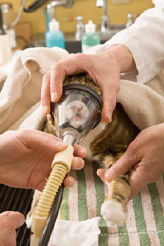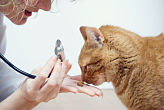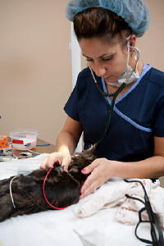Cat Blood Work & Analysis

What does cat blood work really mean?
You probably know that blood will be drawn and analyzed for finding things that will help you protect your cat's health or find cat health issues. But it's not that simple. Since your cat's blood is an amazing concoction of oxygen, water, nutrients, cells, hormones, waste products, and enzymes...the blood work shows what else is present.
The blood can carry toxins, viruses, parasites, bacteria, and other harmful substances. But despite its complex recipe, blood is relatively easy and inexpensive to obtain and analyze.
By carefully examining the cat blood work, it is possible to learn a great deal about the state of your cat's health. While every disease or illness your cat might contract cannot be conclusively diagnosed by cat blood work, only the most minor of afflictions does not have some telltale effect on her blood.
A fundamental understanding of some of the common tests performed on feline blood will help you to understand how cat blood work may be used to monitor your cat's health, to guide your veterinarian in treating illness, and to prevent serious health problems. Although there is a high-tech hand-held blood analyzer which can provide an on-the-spot diagnosis for sick cats, I'll explain the basics in older methods to give you a general understanding of cat blood work.
Complete blood count (CBC)...most common analysis of blood
Although it's a simple and inexpensive screening test for many abnormalities, a CBC consists of several steps. The numbers and types of cells are determined, the fluid surround them is analyzed, and the individual cells are closely examined for abnormalities that may signal infection, cancer, or other disease...the reason for cat blood work.
In the first step of cat blood work, the number of red blood cells (RBC's) in the sample are counted. The RBC's make up such a large portion of the volume of the blood that simply determining how much space they take up in a blood sample indicates whether their numbers are sufficient.
To understand this, think about ice cubes floating in a glass of iced tea....you probably wouldn't count them to determine whether there were enough of them...you would just examine the glass to see how much of its volume they filled.
To determine in the same manner whether there are sufficient RBC's in a cat's blood, a small amount of blood is put in a tiny glass tube called a hematocrit tube and the end of the tube is plugged. Then several tubes are placed, lying horizontally, in a blood centrifuge machine.
The centrifuge spins the tubes around at high speed, like children on a merry-go-round, and the centrifugal force causes the heavy red blood cells to pack tightly against the plug at the outer end of the tube.
The lighter-weight white blood cells (WBC's) form a thin layer on top of the RBC's, and the remainder of the tube then contains only the transparent fluid portion of the blood which is called serum. The column of RBC's, WBC's, and serum in the tiny glass tube is measured. In a healthy cat, the RBC's should fill about 45% of the length of the tube.
In an anemic cat...one who has too few RBC's...the hematocrit may only be 25% or even less, which is cause for serious concern. Cat blood work provides this information.
A few more tests can be performed with this tiny hematocrit tube.
Then serum is carefully observed; dark yellow serum, for example, may indicate malfunction of the liver. The tube is then broken, and the serum is allowed to drip onto the surface of a piece of equipment called a refractometer, used to measure the amount of protein sample. When light is shined through a fluid containing protein, the fluid changes the light in direct proportion to the amount of protein it contains.
So the refractometer, by measuring how much light changes as it shines through the serum from your cat blood work hematocrit tube, demonstrates how much protein is in your cat's blood. A high level of protein may indicate inflammation or cancer. Low levels may be caused by malnutrition, chronic liver disease or other problems.
Then it's time to count the WBC's. Because of their smaller numbers, these blood cells must be counted by a different method. First, a tiny sample of blood is diluted with a pH-balanced fluid. The diluted blood is inserted into a special type of microscope slide called a hemocytometer.
The slide has a shallow chamber that holds a specific volume of the fluid, and overlying this chamber is a glass surface on which a microscopic grid has been etched.
The WBC's within the chamber are easily counted, using the etched lines as guides when the hemocytometer is viewed through a microscope. The results reveal whether or not the cat has an ordinary number of WBC's per volume of blood.
The hemocytometer is also used to count the number of platelets available
Platelets are easily distinguished from WBC's due to their smaller size and disk-like shape. This manual method for counting WBC's and platelets can have up to a 20% margin of error, even when performed by a very experienced examiner so automated cell counters are usually used.
Automated cell counters still have a margin of error but it's less than 5% . Their results are always evaluated with other tests and findings to compensate for errors.
The next step in the CBC is the examination and tally of the individual types of WBC's. This step begins when a small drop of blood is smeared in a thin layer on a glass slide. The smear is dried and treated with a series of stains; each type of cell absorbs the stains differently, making the cell types easier to distinguish.
The slide is viewed under a high power microscope, and one hundred cells are carefully differentiated and counted; this is called a "differential count" of the WCB's.
The number of each type of cell found is then considered to be the percentage of that type of cell present in your cat blood work. For example, suppose that the differential count found that 5 out of 100 WBC's (5%) were eosinophils, and that your cat's total WBC count is 10,000 cells per microliter ( a microliter is one-millionth of a liter of blood; normal cats have between 5,000 and 20,000 WBC's per microliter). Five percent of 10,000 cells are 500 eosinophils, well within the normal range of 0-750 eosinophils found in a healthy cat.
Had there been 10 eosinophils in the differential count, that would have meant there were 1000 eosinophils per microliter of your cat's blood, a high number that would suggest she was suffering from some sort of allergy or parasitic infestation. This would certainly justify having cat blood work done.
Once the counting is completed...
The blood smear is also carefully examined to determine whether any RBC's or WBC's are abnormal. The RBC's, which only live for about four months, are especially useful indicators of disease.
Immature RBD's are smaller and darker than mature ones, so a greater than normal number of small dark RBD's might indicate that your cat has lost blood and is attempting to make up for that loss by hurriedly making even more RBD's than normal.
Certain types of poisons and chemicals can also cause a change in the appearance of RBD's. For example, exposure to toxic levels of lead causes them to be covered with many small purple dots, as if they had the measles. Although this condition would not clearly diagnose lead poisoning in your cat, it would suggest to your veterinarian that additional tests should be conducted.
Abnormal WBC's may signal the presence of cancer, parasitic infection, viral or bacterial disease, or other disease conditions that should be further investigated. Because the job of WBC's is primarily to locate, engulf and destroy microscopic organisms that invade your cat's body, WBC's on the microscope slide may actually be observed to contain bacteria, parasites, and other invaders.
Study of the Serum
Serum is the fluid part of the blood that surrounds the cells, and once the cells have been removed, the serum is also carefully analyzed. Because so much can be learned from this part of the blood these tests are called "serology" or literally "the study of the serum".
And because the panel of tests most commonly performed on serum are biochemical tests, the analysis is referred to as a "serum biochemistry panel", sometimes called simply a "panel" or a "blood profile"...part of cat blood work.
The variety of substances that are detected and evaluated with a biochemistry panel is truly amazing: sugars, hormones, enzymes, minerals. The list is long and varied, and the information it provides about your cat's well-being is invaluable.
For example, glucose is the chief source of energy for living organisms...the final product of the breakdown of carbohydrates in the diet. Because energy is vital to an animal's ability to function, the pancreas secretes the enzyme known as insulin to control those situations in which the body has too much glucose.
Insulin causes excess glucose to either be stored in the liver and muscles or be converted to fat. High blood glucose, or hyperglycemia, may be a signal that the pancreas is malfunctioning and cannot secrete enough insulin, a widely-known condition called diabetes mellitus.
However, there are other causes of hyperglycemia. A very frightened cat may be hyperglycemic because her body has prepared itself for stress, making plenty of glucose available to provide the energy it thinks she will need.
After a cat has eaten, her blood glucose level will be high until it has stored away any glucose she does not immediately need. Because these temporary conditions can mask true hyperglycemia, cats who are suspected of being diabetic must often fast and be kept calm before cat blood work is done.
On the other hand, a cat may have low blood glucose, or hypoglycemia, due to liver disease, the presence of an undetected tumor, prolonged starvation or malnutrition, or a severe bacterial infection which uses up a lot of the body's supply of energy. These will show up in cat blood work.
A serum biochemistry panel is also useful for assessing the health of your cat's kidneys
Malfunction of the kidneys is a common malady of cats, especially older cats. The hallmark symptoms of early kidney failure...excessive thirst and voluminous urination...may be difficult to detect, especially if you share your home with more than one feline friend.
A cat can often double the water intake without necessarily attracting his owner's attention. That's why it's a surprise when cat blood work indicates kidney failure, despite undetected symptoms.
Think of the kidneys as filters for the blood. As the blood flows through them, they let the beneficial parts of the blood flow back into your cat's bloodstream, but they filter out toxins and waste products.
Two of those waste products are: blood urea nitrogen...the other is called creatinine. These are eliminated only through the kidneys. If there is too much of either of them in the bloodstream, it can only be due to the failure of the kidneys to properly filter them out.
Glucose, blood urea nitrogen, and creatinine are a few examples of the substances detected by a serum biochemistry panel during your cat blood work that can help your vet assess your cat's health. The level of other substances can also indicate the quality of function of the body's other organs, including the liver, the gall bladder and heart.
In addition to the CBC and panel, there are other less routine tests
Additional tests may be performed during a cat blood work analysis. Some types of poisons can be detected in the blood by the use of toxicology tests.
Not uncommonly, older cats suffer from overactive thyroid glands, and routine screening of the blood for thyroid hormones is recommended for geriatric cats who may have developed feline hyperthyroidism.
Infection with either feline leukemia virus (FeLV) feline immunodeficiency virus (FIV) may be detected using a specific blood test called an enzyme-linked immunosorbent assay, or "ELISA" test. These ELISA tests look much like a home-pregnancy test kit, and can provide results in a matter of minutes using only a few drops of your cat's blood either during cat blood work or separately.
The information gained from performing cat blood work is not the whole story and must be carefully compared and contrasted to the information your veterinarian garnered by carefully examining your cat, and by thoroughly questioning you about your cat's actions and prior health history.
Even those tests that provide a very specific diagnosis, such as the ELISA test for feline leukemia virus infection, do not provide all of the information your cat's health care provider needs.
The CBC and serum biochemistry panel will contribute additional information about how severely the virus has affected your cat, how his body is responding to the infection, and what methods of treatment might best help him.
All of this information is added together to provide a final answer to your cat's health mysteries, and to point the way to improving and protecting his health.
Cat Blood Work Definitions
Even a tiny drop of your cat's blood contains an amazing array of red and white blood cells. These are some definitions that can help you understand the health of your cat and cat blood work.
- Red Blood Cells (RBC's): Perhaps the best known of all the blood cells these little life preserver-shaped cells...also called erythrocytes...are truly life preservers for your cat. RBC's carry molecules of oxygen from a cat's lungs to all of the other tissues of his body. A deficiency of RBC's is called anemia, and may be caused by many things, including failure to make enough RBD's (perhaps due to lack of iron, an essential ingredient in the makeup of every RBC) or loss of RBC's due to parasites or bleeding of external or internal wounds.
- White Blood Cells (WBC's): WBCs have two basic parts: the nucleus, or "brains" of the cell, and the cytoplasm, or body, of the cell. WBDs can be distinguished from one another based on the size of these two parts, the overall size of the cells, and the colors of the cells after they are subjected to a series of special stains. One cell's nucleus may stain dark purple, while another will become pale blue. These cells do battle with infections.
- Lymphocytes: These are WBCs consisting mostly of a large purple nucleus, surrounded by a small amount of cytoplasm. Lymphocytes tend to "remember" certain diseases, especially viruses, and quickly protect animals against a disease to which they've been exposed before. They are the primary cells of immunity. Excess numbers of lymphocytes are found in a cat that is attempting to fight off an infectious disease.
- Basophils: These WBCs have dark purple granules in their cytoplasm and are found only rarely in the blood of cats. Their presence might indicate infection with heartworms, or chronic disease of the liver or kidneys.
- Monocytes: These cells have a large blue nucleus. Theses WBCs are seen in larger numbers whenever an animal has an infected wound or any other condition that causes the body to produce pus.
- Neutrophils: These easily recognized cells are the most common WBCs in cats, and they go to work any time the body develops inflammation due to parasites, bacteria, viruses, fungi, cancer, burns, or any other causes. Pus is primarily made up of dead neutrophils.
- Eosinophils: These cells have red granules in their cytoplasm and are easy to recognize. Although these WBCs are usually somewhat rare, their numbers increase when a cat develops an allergic condition or is infested with some type of parasite.
- Platelets: Also called thrombocytes (named for their role in the formation of a blood clot or "thrombus"), these disk-shaped structures are found in the blood, along with the RBCs and WBCs. Platelets are not really cells, but instead are small bits of cytoplasm which have broken off from a large cell found in the bone marrow. When a blood vessel is cut, platelets stack themselves up against the edge of the cut, forming a plug that...depending on the size of the injured vessel ...may stop the bleeding altogether.
Related Articles......
Return from Cat Blood Work to Cat Health Homepage
Having trouble finding what you need? Cat Health Index & Site Map
OR
Do you have a question to ask?...Questions
OR
Do you have a cat story to share?...Simply click here to go to that page!
Copyright@2010-2020 All rights reserved.Cat-health-detective.com
This website is information only. Consult a veterinarian for medical assistance

"Like Us" on Facebook
or...
"Like Us" here




















